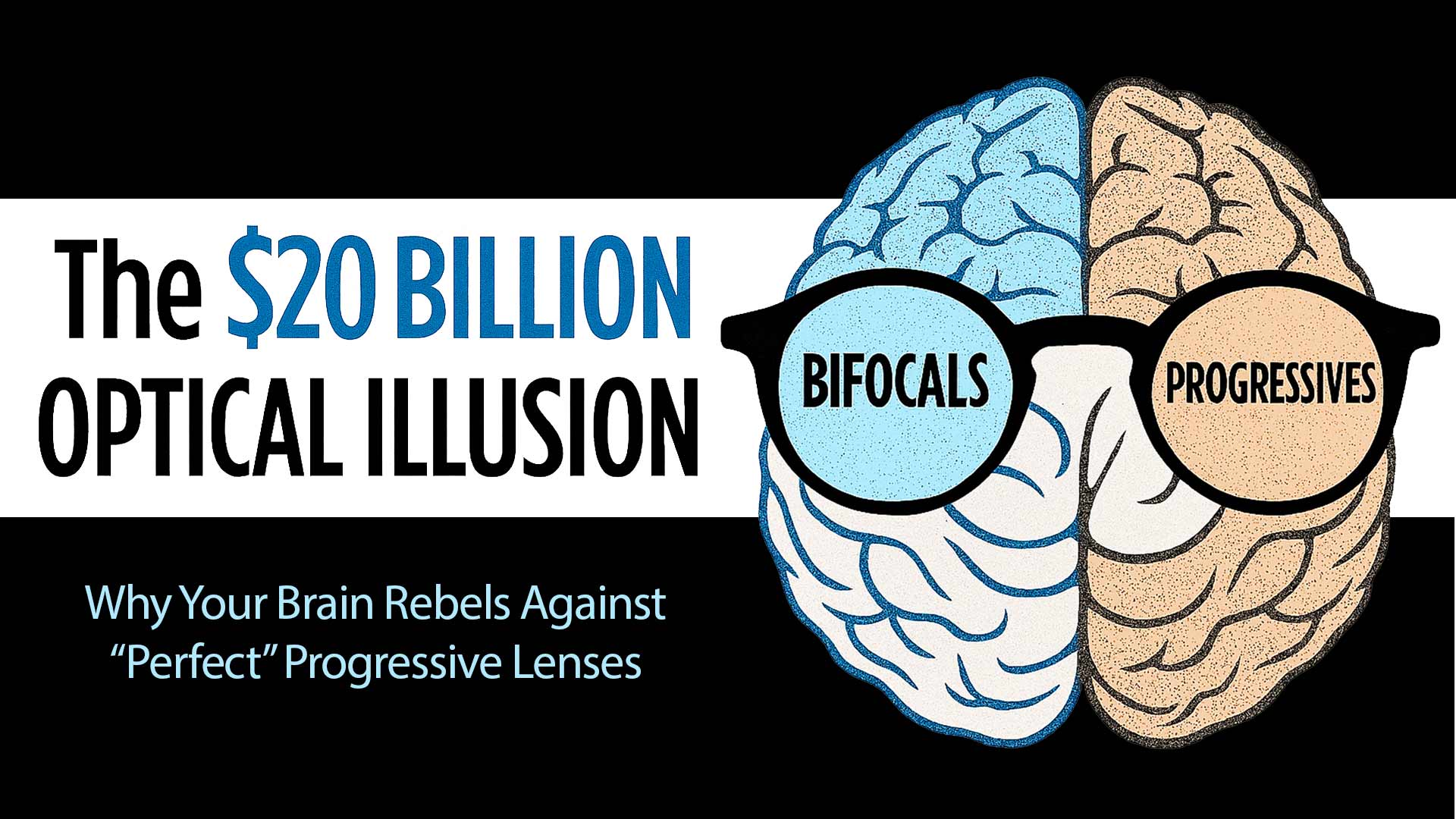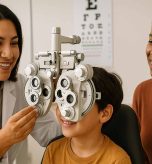The $20 Billion Optical Illusion: Why Your Brain Rebels Against “Perfect” Progressive Lenses
And why 1 in 4 people abandon them within the first month… and our Top 5 tips to adapt
Top 5 Tips to adapt to progressive lenses Here’s a mind-bending fact that might make you rethink everything you know about modern eyewear: 96% of people consider progressive lenses “good or very good” once they adapt to them, yet the global progressive lens market (worth over $20 billion annually) suffers from an astonishing abandonment rate that would make any other industry panic. What’s going on here? The answer lies in a fascinating battle between engineering perfection and human neurology. Progressive lenses represent one of the most sophisticated optical achievements of the 21st century, cramming three distinct prescription zones into a single piece of curved glass thinner than a contact lens. But here’s the catch, and this is where it gets really interesting: your brain wasn’t designed for this kind of optical trickery.
The Neurological Rebellion: When Your Brain Says “No Thanks”
Let me start with something that’ll blow your mind: when you put on progressive lenses for the first time, you’re essentially asking your 150,000-year-old visual system to suddenly operate a piece of technology that didn’t exist until 1959. No wonder there’s some pushback. The core issue isn’t just that progressive lenses require “a different way of seeing,” though that’s certainly true. The real problem is neuroplasticity lag. Your brain has spent decades, maybe your entire adult life, learning precisely how to coordinate head movements, eye movements, and focus adjustments with your previous glasses or natural vision. Now suddenly, looking through the “wrong” part of the lens doesn’t just cause blurred vision; it can trigger actual nausea and dizziness because your vestibular system (that’s your inner ear balance mechanism, by the way) gets confused signals. Think about this: 97% of participants successfully adapted to progressive lenses when fitted with proper measurements, but here’s what the studies don’t emphasize… the adaptation period can range from a few days to several months. During this time, your brain is literally rewiring itself, creating new neural pathways for this hybrid way of seeing. But wait, it gets more interesting. Recent research has revealed that people who successfully adapt to progressives show measurably different eye movement patterns than those who struggle. Vergence dynamics were on average faster and the ability to change vergence dynamics was also greater for presbyopes who adapted to progressive lenses. In plain English? Some people’s eyes are just naturally better at the complex dance required for progressive lens success.The “Swim” Effect: When Physics Meets Biology
Now, about those peripheral distortions everyone complains about, what we call the “swim” effect. This isn’t a design flaw; it’s an inevitable consequence of optical physics. When you’re packing three different prescriptions into one continuous lens surface, you’re essentially creating controlled distortion. It’s like trying to display a 3D world on a 2D screen… some compromise is unavoidable. Here’s a fascinating detail most people never learn: the peripheral blur zones in progressive lenses aren’t random. They’re mathematically calculated to minimize interference with your central vision while providing the smoothest possible transition between viewing zones. The engineers who design these lenses use algorithms that would make NASA jealous, optimizing for over 40 different parameters including your specific prescription, pupil distance, facial anatomy, and even your typical head-turning habits. But (and this is crucial) not everyone perceives these distortions equally. Some people are exquisitely sensitive to peripheral visual changes (we call them “peripheral processors”), while others barely notice unless you point it out to them. It’s similar to how some people get carsick easily while others can read in a moving vehicle without any issues. The stair-walking problem deserves special mention here because it highlights something profound about human vision. When you’re walking downstairs, you’re not just looking at the steps… you’re using peripheral vision to judge depth, distance, and spatial relationships. Progressive lens distortions can interfere with this process, which is why several studies have found that people who wear multifocal glasses were twice as likely to fall. That’s not just an inconvenience; that’s a legitimate safety concern, especially for older adults.The Millimeter Mistake: When Precision Becomes Critical
This brings us to perhaps the most crucial factor: fitting precision. And honestly, this is where the industry can fail people spectacularly. Progressive lenses must be positioned with sub-millimeter accuracy. I have worked with practitioners who claimed that taking the correct fitting heights for their progressive lens patients was unnecessary… the failure rate was so high that the lens companies would send out their representatives to figure out what was going wrong. That’s a real quote from an optical professional, and it reveals a shocking truth about the industry. Here’s what happens when the optical center is off by just 2-3 millimeters: your brain receives conflicting information about where to look for clear vision. It’s like having a GPS that’s consistently wrong by a block or two… you’ll eventually get there, but the journey will be frustrating and inefficient. Some people can compensate for minor fitting errors through unconscious head positioning adjustments, but others simply can’t, leading to headaches, eye strain, and eventual abandonment of the lenses. The prescription updating issue is equally critical. Progressive lenses are unforgiving of outdated prescriptions in ways that single-vision lenses aren’t. A minor prescription change that might be barely noticeable in regular glasses can completely disrupt the delicate balance of a progressive lens design.The Real Success Story (And Why It’s More Complicated Than Anyone Admits)
Despite all these challenges, here’s the remarkable thing: most people do eventually adapt. The human visual system is incredibly plastic, capable of learning new patterns and compensations that would seem impossible if you described them in advance. Professional fitting makes an enormous difference, but it’s not just about measurements. It’s about education, expectation setting, and ongoing support during the lens adaptation period. The best optical professionals don’t just hand you progressive lenses and wish you luck… they schedule follow-up appointments, provide specific adaptation exercises, and adjust the lenses if necessary. But let’s be honest about something the industry doesn’t like to discuss: some people simply aren’t good candidates for progressive lenses, regardless of how perfectly they’re fitted or how patient they are during adaptation. Whether it’s due to visual processing differences, occupational demands, or individual sensitivity patterns, alternatives like separate reading glasses or computer-specific lenses might be better solutions. The key insight? Progressive lenses aren’t a one-size-fits-all solution, despite being marketed that way. They’re a sophisticated tool that works brilliantly for the right person in the right circumstances with the right fitting… but that’s a lot of variables that need to align perfectly. Understanding this complexity (rather than expecting instant adaptation) is often the difference between progressive lens success and another pair of expensive glasses gathering dust in a drawer.Top 5 Tips to Adapt to Progressive Lenses
- Get a Precision Fit Sub-millimeter accuracy matters. Always get professionally measured—fitting errors are the #1 reason people abandon progressives.
- Update Your Prescription First Progressive lenses exaggerate even tiny prescription inaccuracies. Don’t cut corners—make sure your Rx is current.
- Move Your Head, Not Just Your Eyes Train yourself to turn your head toward what you’re focusing on. This keeps you in the lens’s “sweet spot.”
- Stick With It Daily Wear them consistently. Switching back and forth with old glasses resets your progress and confuses your brain.
- Follow Up & Ask for Adjustments If something feels off after a few days, go back. Small tweaks in frame position or lens alignment can make a huge difference.
Your brain processes visual information in just 13 milliseconds, faster than the blink of an eye (which takes about 100–150 milliseconds). Yet that same hyper-efficient organ can take 30 to 90 days to adapt to progressive lenses — and 1 in 4 users quit before then. Let that sink in:
A biological machine that deciphers the visual world in fractions of a second… might need months to accept a pair of scientifically “perfect” lenses. Mind Boggling Progressive Lenses Fact!


